DELAFIELD, Wis. (Stockpickr) -- Trading stocks that trigger major breakouts can lead to massive profits. Once a stock trends to a new high or takes out a prior overhead resistance point, then it's free to find new buyers and momentum players who can ultimately push the stock significantly higher.
>>5 Stocks Under $10 Set to Soar
Breakout candidates are something that I tweet about on a daily basis. I frequently tweet out high-probability setups, breakout plays and stocks that are acting technically bullish. These are the stocks that often go on to make monster moves to the upside. What's great about breakout trading is that you focus on trend, price and volume. You don't have to concern yourself with anything else. The charts do all the talking.
Trading breakouts is not a new game on Wall Street. This strategy has been mastered by legendary traders such as William O'Neal, Stan Weinstein and Nicolas Darvas. These pros know that once a stock starts to break out above past resistance levels and hold above those breakout prices, then it can easily trend significantly higher.
>>5 Stocks Insiders Love Right Now
With that in mind, here's a look at five stocks that are setting up to break out and trade higher from current levels.
SPDR Gold Shares
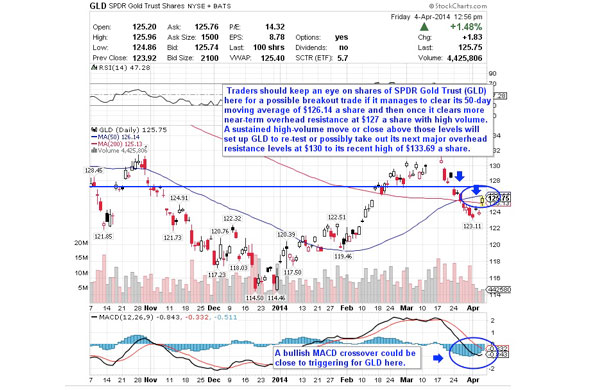
One gold ETF that's starting to move within range of triggering a near-term breakout trade is SPDR Gold Shares (GLD), which has an investment objective to reflect the performance of the price of gold bullion. This ETF is off to a decent start in 2014, with shares up around 8%.
>>Buy These 5 Blue Chips Before They Hike Their Dividends Again
If you take a look at the chart for SPDR Gold Shares, you'll notice that this stock has sold off pretty hard over the last few weeks, with shares dropping sharply from its high of $133.69 to its recent low of $123.11 a share. During that drop, shares of GLD have been consistently making lower highs and lower lows, which is bearish technical price action. That said, GLD has now started to bounce off that $123.11 low and it's quickly moving within range of triggering a near-term breakout trade.
Traders should now look for long-biased trades in GLD if it manages to break out above its 50-day moving average of $126.14 a share and then once it clears more near-term overhead resistance at $127 a share with high volume. Look for a sustained move or close above those levels with volume that hits near or above its three-month average volume of 7.95 million shares. If that breakout triggers soon, then GLD will set up to re-test or possibly take out its next major overhead resistance levels at $130 to its recent high of $133.69 a share.
Traders can look to buy GLD off weakness to anticipate that breakout and simply use a stop that sits right below some near-term support at $123.11 a share or around $120 a share. One can also buy GLD off strength once it starts to clear those breakout levels with volume and then simply use a stop that sits a comfortable percentage from your entry point.
Imax
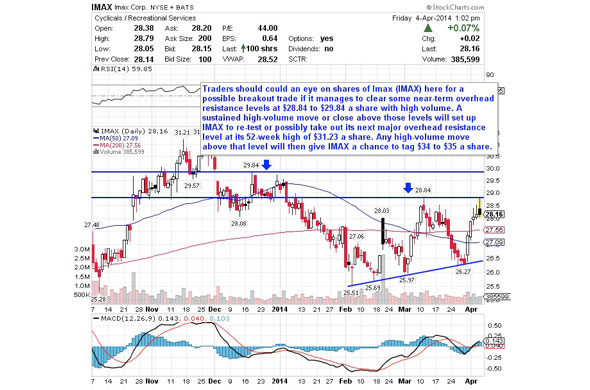
A entertainment technology player that's starting to trend within range of triggering a near-term breakout trade is Imax (IMAX), which specializes in motion picture technologies and presentations. This stock is up modestly over the last six months, with shares up by around 6%.
>>4 Big Stocks on Traders' Radars
If you take a look at the chart for IMAX, you'll see that this stock recently formed a double bottom chart pattern at $25.97 to $26.27 a share. Following that bottom, shares of IMAX have started to rip higher and move back above both its 50-day and 200-day moving averages. That spike is quickly pushing shares of IMAX within range of triggering a near-term breakout trade.
Traders should now look for long-biased trades in IMAX if it manages to break out above some near-term overhead resistance levels at $28.84 to $29.84 a share with high volume. Look for a sustained move or close above those levels with volume that hits near or above its three-month average action of 486,124 shares. If that breakout triggers soon, then IMAX will set up to re-test or possibly take out its next major overhead resistance level at its 52-week high of $31.23 a share. Any high-volume move above that level will then give IMAX a chance to tag $34 to $35 a share.
Traders can look to buy IMAX off weakness to anticipate that breakout and simply use a stop that sits right below its 50-day at $27.10 a share or around those double bottom support levels. One could also buy IMAX off strength once it starts to clear those breakout levels with volume and then simply use a stop that sits a comfortable percentage from your entry point.
China Techfaith Wireless Communication Technology
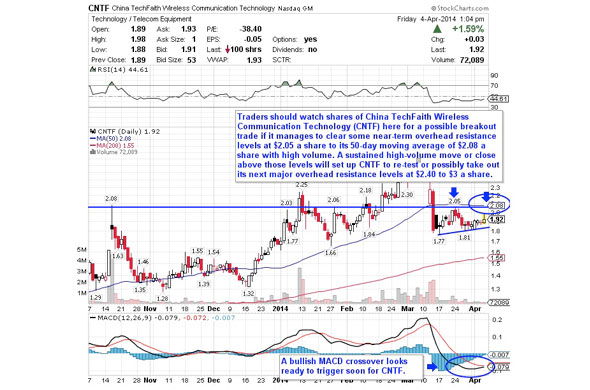
Another technology player that's starting to trend within range of triggering a big breakout trade is China Techfaith Wireless Communications Technology (CNTF), which engages in the original design, development and sale of handsets. This stock has been in play with the bulls over the last six months, with shares up sharply by 32%.
>>Must-See Charts: 5 Breakout Trades From the Tech Sector
If you take a glance at the chart for China Techfaith Wireless Communication Technology, you'll notice that this stock recently sold off from its high of $3.01 to its low of $1.77 a share. During that drop, shares of CNTF were consistently making lower highs and lower lows, which is bearish technical price action. Shares of CNTF have now started to stabilize a bit and uptrend modestly from its low of $1.77 to its recent high of $2.05 a share. This stock is now starting to uptick a bit today as it moves within range of triggering a big breakout trade.
Traders should now look for long-biased trades in CNTF if it manages to break out above some near-term overhead resistance levels at $2.05 a share to its 50-day moving average of $2.08 a share with high volume. Look for a sustained move or close above those levels with volume that hits near or above its three-month average action of 540,900 shares. If that breakout materializes soon, then CNTF will set up to re-test or possibly take out its next major overhead resistance levels at $2.40 to $3 a share.
Traders can look to buy CNTF off weakness to anticipate that breakout and simply use a stop that sits right below some key near-term support levels at $1.81 to $1.77 a share, or even around $1.66 a share. One can also buy CNTF off strength once it busts above those breakout levels share with volume and then simply use a stop that sits a comfortable percentage from your entry point.
Fortuna Silver Mines
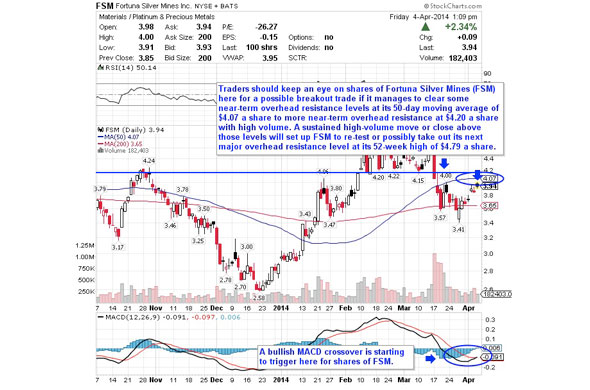
Another basic materials player that's starting to trend within range of triggering a near-term breakout trade is Fortuna Silver Mines (FSM), which engages in the exploration, extraction and processing of silver and gold properties in Latin America. This stock is off to a strong start in 2014, with shares up sharply by 37%.
>>Chart Smarts: Trade These 5 Big Stocks for Gains in April
If you look at the chart for Fortuna Silver Mines, you'll notice that this stock recently topped out at $4.79 a share and then subsequently dropped sharply to its low of $3.41 a share. During that drop, shares of FSM were consistently making lower highs and lower lows, which is bearish technical price action. That said, shares of FSM have now started to rebound off that $3.41 low and it has trended back above its 200-day moving average. This bounce is quickly pushing shares of FSM within range of triggering a near-term breakout trade.
Traders should now look for long-biased trades in FSM if it manages to break out above some near-term overhead resistance levels at its 50-day moving average of $4.07 a share to more near-term overhead resistance at $4.20 a share with high volume. Look for a sustained move or close above those levels with volume that hits near or above its three-month average action of 301,124 shares. If that breakout gets underway soon, then FSM will set up to re-test or possibly take out its next major overhead resistance level at its 52-week high of $4.79 a share.
Traders can look to buy FSM off weakness to anticipate that breakout and simply use a stop that sits right below its 200-day moving average of $3.65 a share or around more support at $3.41 a share. One can also buy FSM off strength once it starts to clear those breakout levels with volume and then simply use a stop that sits a comfortable percentage from your entry point.
B2Gold
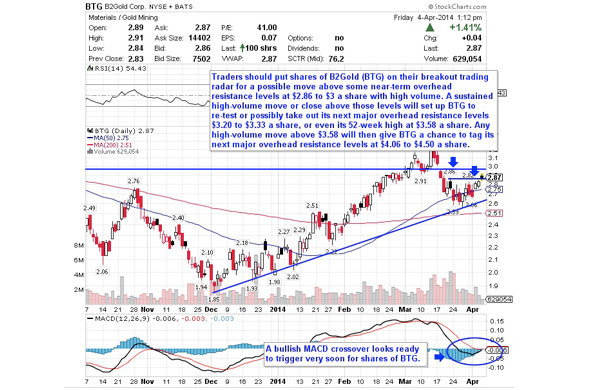
My final breakout trading prospect is gold mining player B2Gold (BTG), which explores for and develops mineral properties in Nicaragua, the Philippines, Namibia, Burkina Faso and Colombia. This stock has been in play with the bulls so far in 2014, with shares up by a whopping 42%.
>>3 Stocks Spiking on Big Volume
Top Construction Material Companies To Own In Right Now
If you look at the chart for B2Gold, you'll see that this stock recently pulled back off its high of $3.33 to its low of $2.59 a share. During that decline, shares of BTG were consistently making lower highs and lower lows, which is bearish technical price action. That pullback took shares of BTG right to its 200-day moving average, where buyers have for now stepped in to support the stock. Shares of BTG are now starting to rebound higher off that $2.59 low and the stock is trending back above its 50-day moving average at $2.75 a share. That move is quickly pushing shares of BTG within range of triggering a big breakout trade.
Traders should now look for long-biased trades in BTG if it manages to break out above some near-term overhead resistance levels at $2.86 to $3 a share with high volume. Look for a sustained move or close above those levels with volume that hits near or above its three-month average action of 1.83 million shares. If that breakout triggers soon, then BTG will set up to re-test or possibly take out its next major overhead resistance levels $3.20 to $3.33 a share, or even its 52-week high at $3.58 a share. Any high-volume move above $3.58 will then give BTG a chance to tag its next major overhead resistance levels at $4.06 to $4.50 a share.
Traders can look to buy BTG off weakness to anticipate that breakout and simply use a stop that sits right around its 200-day moving average of $2.51 a share. One can also buy BTG off strength once it starts to take out those breakout levels with volume and then simply use a stop that sits a conformable percentage from your entry point.
To see more breakout candidates, check out the Breakout Stocks of the Week portfolio on Stockpickr.
-- Written by Roberto Pedone in Delafield, Wis.
RELATED LINKS:
>>3 Stocks Under $10 Moving Higher
>>Sell This Momentum Stocks Before It's Too Late
>>Crash-Proof Your Portfolio With These 5 Sin Stocks
Follow Stockpickr on Twitter and become a fan on Facebook.
At the time of publication, author had no positions in stocks mentioned.
Roberto Pedone, based out of Delafield, Wis., is an independent trader who focuses on technical analysis for small- and large-cap stocks, options, futures, commodities and currencies. Roberto studied international business at the Milwaukee School of Engineering, and he spent a year overseas studying business in Lubeck, Germany. His work has appeared on financial outlets including
CNBC.com and Forbes.com. You can follow Pedone on Twitter at www.twitter.com/zerosum24 or @zerosum24.


 Related NFLX Netflix Acquires Print the Legend Rights - Analyst Blog Five Star Stock Watch: Netflix, Inc. Tech Titans Take on Immigration Reform (Fox Business) Related ALXN Dyax Corp. (DYAX) in Focus: Stock Up 6% - Tale of the Tape Exact Sciences (EXAS) Jumps: Stock Adds 10.2% in Session - Tale of the Tape
Related NFLX Netflix Acquires Print the Legend Rights - Analyst Blog Five Star Stock Watch: Netflix, Inc. Tech Titans Take on Immigration Reform (Fox Business) Related ALXN Dyax Corp. (DYAX) in Focus: Stock Up 6% - Tale of the Tape Exact Sciences (EXAS) Jumps: Stock Adds 10.2% in Session - Tale of the Tape